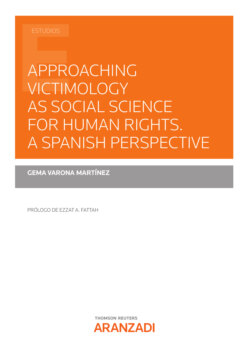Читать книгу Approaching Victimology as social science for Human rights a Spanish perspective - Gema Varona Martínez - Страница 20
1.3.1. Risk and vulnerability
ОглавлениеThe notion of victim risk can run parallel to the idea of violence risk and protective factors. Hence we can apply it from a victim, offender or community perspective. Victim risk should be mainly understood before the crime, as the inequality in the distribution of the possibility or chance to become a victim of a certain crime. In this text, victim vulnerability refers to another moment; the inequality of the impact of the crime, once committed, that is, the different degree of capability of being materially, physically or emotionally wounded.
Notwithstanding hidden victimisation, according to various studies (Lauritsen and Rezey, 2018; Wiedlitzka, 2020), people at higher risk for violent victimisation are likely to be young, male, unmarried, with low or middle levels of income and from minority group backgrounds (ethnic minorities, LGBTI communities, people with disabilities, (un)documented immigrants, homeless etc.). The higher risk might also correspond to higher vulnerability.
According to the European Institute for Gender Equality, risk and vulnerability factors are related to:
• the victim (e.g. age/gender/sexual orientation/ethnic origin/pregnancy/being new born, depression/other mental health issues/disabilities/isolation);
• the perpetrator (e.g. history of violence, mental health issues, access to weapons, previous or current breach of protection order);
• the relationship between the victim and the offender (family members/neighbours/offender’s authority or power position);
• the community (e.g. poverty, lack of institutional support);
• social risks (external conditions such as norms and practices that may exacerbate the level of risk for a victim).
Beyond specific crimes, Articles 22 and 23 of the Spanish criminal code consider many of these factors. Vulnerability has also to do with the duration and harming potential of the victimisation in terms of violence and scale of the harm.
At the same time, in terms of positive Victimology, risk and vulnerability factors are usually studied balancing the protective and resilience factors. These kinds of factors have to be thought of on a dynamic and interactive basis. Critical thought can also be added as explained above in relation to the expansive and identity-related notion of “vulnerable victim”. According to the 2029/12/EU Directive, only children are always considered to be vulnerable victims. However, every victim has a right to individual assessment of his or her individual protection needs and to be protected from any further harm that is related to their participation in the criminal proceedings. In practice, this means that the competent authorities (such as police, prosecutor and/or specially trained staff) will assess the individual needs of every victim, and identify the victims who are the most vulnerable. Such victims will be protected by specific measures. According to the Directive, particular attention shall be paid to victims who have suffered considerable harm due to the severity of the crime; victims who have suffered a crime committed with a bias or discriminatory motive which could, in particular, be related to their personal characteristics and victims whose relationship to and dependence on the offender make them particularly vulnerable. In this regard, victims of terrorism, organised crime, human trafficking, gender-based violence, violence in a close relationship, sexual violence, exploitation or hate crime, and victims with disabilities shall be, among others, duly considered (for a complete list on potential vulnerable victims, see paragraphs 38, 56, 57 and 58 of the Directive Preamble and Article 22).
